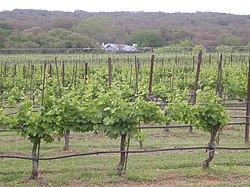Texas has a long history of wine production. The sunny and dry climate of the major winemaking regions in the state have drawn comparison to Portuguese wines, in addition to other regions in Europe like Spain, France, and Italy.[2] Some of the earliest recorded Texas wines were produced by Spanish missionaries in the 1650s near El Paso. Texas ranked as the fifth largest wine producing state by 2019.[3]
The state is home to over 42 members of the Vitis grape vine family with fifteen being native to the state, more than any other region on earth.[1][4] As of 2019, the state had over 5,000 acres (2,000 ha) planted with Vitis vinifera.[1] Despite being the largest of conterminous states, this relatively small amount of planted land is dwarfed by the production of even the smallest French AOCs like Sancerre. The Texan wine industry is continuing its steady pace of expansion and has gained a reputation as an established wine growing region in the United States.[5]
- ^ a b c d "2019 Texas Wine Grape Varieties" (PDF). United States Department of Agriculture National Agricultural Statistics Service. Retrieved September 30, 2024.
- ^ MacNeil, Karen (February 1, 2000). The Wine Bible. Workman Publishing. p. 623. ISBN 978-1-56305-434-1.
- ^ "New York Ranks Third in Wine Production". Wines Vines Analytics.
- ^ Johnson, Hugh; Robinson, Jancis (October 8, 2013). The World Atlas of Wine (7th ed.). Mitchell Beazley Publishing (first published 1971). p. 286. ISBN 978-1845333010.
- ^ MacNeil (2000), pp.750–754.
